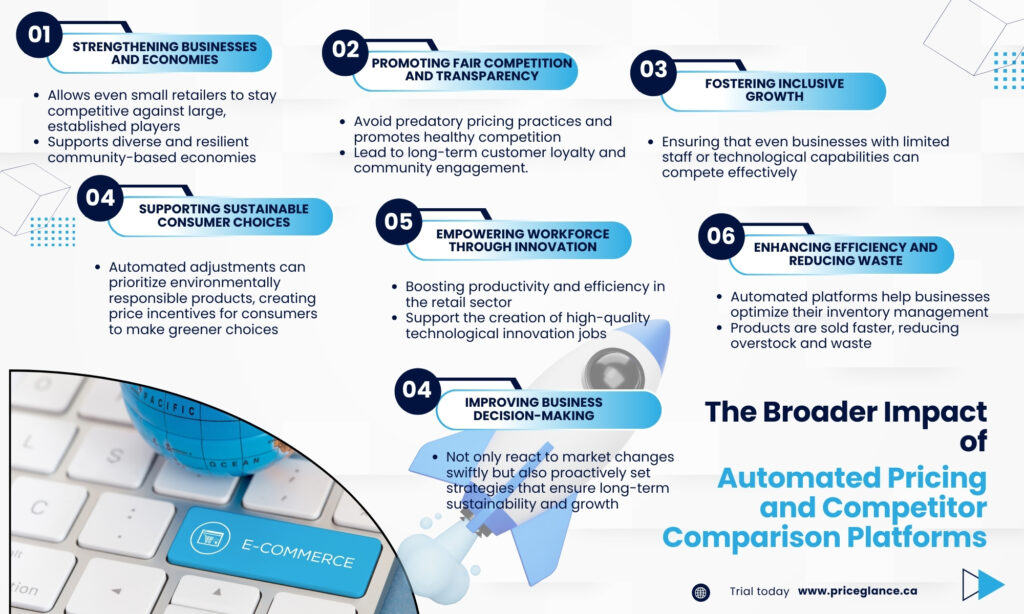
Automated pricing platforms in e-commerce are not just tools for enhancing business profitability; they also bring numerous social, economic, and environmental benefits. By automating complex pricing decisions, optimizing margins, and ensuring competitiveness, these platforms significantly impact the broader landscape, from fostering economic inclusivity to driving sustainable practices. A key feature that further enhances their value is real-time competitor price comparison and automatic price adjustments based on desired profit margins and cost fluctuations.
Dynamic Competitor Price Comparison and Automated Adjustments
One of the most powerful functions of these platforms is the ability to continuously monitor and compare competitors’ prices in real time. Retailers no longer need to manually check market rates or react too slowly to price changes. The platform automatically analyzes competitor prices and adjusts accordingly, ensuring that sellers maintain competitive pricing while safeguarding their margins.
In addition to competitor tracking, these platforms also automatically update retail prices based on the cost of goods sold and the retailer’s desired profit margins. This dynamic adjustment ensures that businesses not only stay competitive but also maintain profitability, even in fluctuating market conditions. The platform can automatically enable or disable pricing features to guarantee that both the seller and buyer receive the best price, balancing profit margins with customer satisfaction.
Economic and Social Impact of Real-Time Competitor Pricing

This real-time competitor price comparison, combined with automated adjustments based on cost and margin, has far-reaching implications for the economy and society.
- Strengthening Small Businesses and Local Economies: The ability to adjust prices dynamically allows even small retailers to stay competitive against large, established players. By empowering smaller businesses with the same pricing intelligence as bigger companies, local businesses can thrive, keeping wealth within communities and supporting regional economies. This supports the government goal of fostering diverse and resilient community-based economies.
- Promoting Fair Competition and Transparency: Automated competitor price tracking ensures that pricing remains transparent and fair for consumers. This helps avoid predatory pricing practices and promotes healthy competition. When consumers know they are getting competitive rates, they develop greater trust in local businesses, leading to long-term customer loyalty and community engagement.
- Fostering Inclusive Growth: Automated pricing and competitor comparison can have a particularly strong impact on underrepresented and minority-owned businesses, including Indigenous entrepreneurs. These groups often face additional challenges in staying competitive due to resource constraints. The automation of price management lowers the entry barrier, ensuring that even businesses with limited staff or technological capabilities can compete effectively.
- Supporting Sustainable Consumer Choices: Retailers can also use these platforms to promote sustainable products by offering competitive pricing on eco-friendly goods. Automated adjustments can prioritize environmentally responsible products, creating price incentives for consumers to make greener choices. This aligns with broader environmental goals of reducing carbon footprints and promoting sustainability.
- Empowering Workforce Through Innovation: The rise of automated retail pricing systems, including competitor tracking and price adjustment platforms, is not only transforming business operations but also contributing significantly to job creation within the tech sector. Moreover, the development of these systems contributes to the broader economy by boosting productivity and efficiency in the retail sector. As retailers leverage automation to streamline pricing processes, they free up resources to invest in other areas, such as customer service, product development, and market expansion. In this way, automated pricing systems enhance competitiveness for businesses and support the creation of high-quality jobs that push the boundaries of technological innovation.
- Enhancing Efficiency and Reducing Waste: By aligning prices with real-time market demand and competitor trends, automated platforms help businesses optimize their inventory management. Products are sold faster, reducing overstock and waste, which minimizes the environmental impact of unsold goods. This contributes to a more sustainable retail environment, aligning with government climate goals and reducing waste at both business and consumer levels.
- Improving Business Decision-Making: The integration of automated competitor price tracking and margin-based adjustments provides retailers with real-time insights, allowing them to make data-driven decisions more effectively. This enables businesses to react to market changes swiftly and proactively set strategies that ensure long-term sustainability and growth. The combination of smarter decisions and better tools means that businesses of all sizes can adapt to market conditions more seamlessly, improving their resilience in a volatile economy.
A Future-Ready Solution for E-Commerce Ecosystem
As AI and machine learning further integrate into pricing platforms, the impact of automated competitor price comparison will become even more profound. These technologies will allow retailers to predict market trends more accurately, optimize pricing strategies for individual consumer preferences, and make more informed decisions in real time.
Price Glance is a competitor price monitoring and recommendation system designed to assist retailers in automatically tracking and making price recommendations. By leveraging intelligent analysis and suggestions, this platform helps boost revenue and profits by providing automated price recommendations. With the aim of supporting small and medium-sized businesses, Price Glance not only enhances competitiveness but also optimizes human resource investment, achieving maximum efficiency through technology.
Ultimately, these platforms are not just tools for optimizing retail prices — they are catalysts for a more inclusive, competitive, and sustainable future for the economy. By helping businesses stay competitive, promoting fair pricing, enhancing workforce skills, and reducing environmental impact, automated pricing and competitor comparison platforms are making significant contributions to long-term growth and success.
